Pairs Tactical Flying
The Section:
A section (pair) is the basic unit in which we fight.
This pair should not be split under normal circumstances. Inside the
pair one pilot is considered the "section leader" and the other is his
"wingman". The "leader's" job is to steer the pair. ie: his wingman,
unless of course he's also the formation (4some) leader.
In the tactical sense, both these pilots are equal
- both attack and watch out for each other.
for some info about how to keep in formation, and turning
the formation see the "Formation
Flyin" page.
2 vs. 1 Situations:
- A head-on situation vs. a single bandit.
- If there is enough time to get orgenized, spread should not be very
large so bandit would point close to a head-on with both planes and
keep the symmetry. When in doubt, open the spread immediatly.
- At about d3.5-4.0 the pair splits and widens the spread up to d1.0-1.2
so bandit would have to make a choise between the two.
- Defending to one side, bandit turns his 6 to the other.
- Important: best bandits reaction (by his POV) is to choose
side early, going over/under one wingman and turning toward the other.
Thus he would turn his side and not his 6 to the other wingman - good
but not best. Splitting too late or not wide enough, would not give
enough seperation to turn into the bandits 3 and 9.
- Here is a rough sketch:
-
The Weave (aka "Thuch weave") -
- In this situation, the pair finds a bandit on their tail, too close
to "cross-split" toward him.
- The pair starts to increase the spread so the bandit has to choose
a side.
- When his choise is clear, the attacked wingman preform gun defence,
dragging the bandit.
- Second wingman closing back, attacking bandit's 5/7 direction.
- Timed right, this might enable the second wingman to take a snapshot
at the bandit, as he crosses his flight path. Should the badit try to "saddle
up", he'll find hiself sadwitched.
- The general principle here is good for a lot of situations (example,
see below about "dragging") : Got a badits long and closing on your 6? cut
infront of your wingman's nose (and let him know what you are doing!).
- On the blackboard you can find drawnings of these moves:
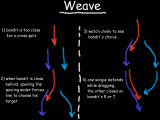
- In this situation the wingmen are in a furball and no longer in formation.
- One wingmember is dragging a bandit and turns toward his wingman to
help closing the distance.
- While dragging try to lower the bandit - lower than your wingman.
- DO NOT go under/above your wingman. Instead, break 90 degrees to one
side and drag the bandit ACROSS the wingman's nose. Timing should be
so that wingman would be able to catch up with you.
- Bandit faces 2 options:
- Continue the chase - thus turning his belly to aiding wingman
and loosing sight of him.
- Head for the wingman - not to expose himself to an attack.
In this case providing your E is enough, reverse after him.
- The drawing is on the blackboard:
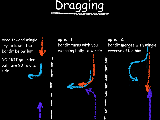
2 vs. 2 Situations:
There is much more veriety here but here are 2 basic options:
-
Bandits in line astern -
- If the rear bandit is sloppy and laggs far behind, preform a "bracket
attack" on the leader. The wingman that the leading bandit turned
to (check "bracket attack") continues to the rear bandit.
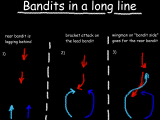
- If they are close, preform a "bracket attack" on the rear bandit.
Leading bandit should be at an angle disadvantage and will take time
to turn.
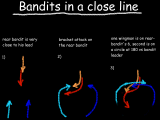
-
Bandits in line abreast -
- Bandit might fly using the same tactics as we do. In this case due
to the symmetry of the problem if they do what we do there should
be no advantage/disadvantage from tactical manuvering (there are still
E, turn-rate, speed issues of course).
- As a rule, best situation is when we pass "one on one" with
their pair. Meaning, each pilot head-ons the bandit on his side (watch
out for HO killing dweebs).
- Then each pilot turns to attack the other bandit preforming a "cross
split" like geometry.
- If we have the alt and BnZ them we can zoom back up still in formation.
- If the bandits break to the same side, they will form line-astern
where leader will be at an angle disadvantage and we attack the helpless
rear.
- Bandits breaking "inside" preforming their own cross split,
negate this manuver due to symetry.
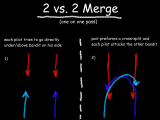
-
Merging wider than bandits -
- As a rule, it's better to merge when our spread is larger than
the bandit pair's.
- On the merge this forces the bandits to turn "outward" and
face each of us HO (otherwise they loose angles), while we are turning
"inward".
- we make the regular cross-split and exchange targets ending up
with angle advantage.
- The bandits have more angles to turn again into the center of
the fight and this buys us a few threat free seconds and the first
move of the fight.
- Note: if they open wide, and we open even wider this might lead
into a two 1on1 fights and need to be adressed as such.
- Here's a scetch:
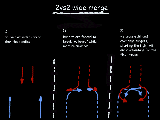
The Furball:
Once entangeled in a furball, formations breaks. But that
doesn't mean that the pair breaks or stop working together. The wingman
and leader should stay within the same furball, watching each other all
the time! Do not run-off chasing bandits, always keep a fair distance
from your wingman/leader so you can help him / ask for help and give 6
calls.
A good strategy with E fighters, when in an advantage, is
to co-ordinate attacks by the pair on the same bandit. Taking them out
one-by-one is the best way to go.
For some general guidlines about pairs in a furball check:
Guidlines
for pair fighting.
give credit where credit is due:
thx to "56th
figher group" for giving ideas for the illustrations here, and correct
english terms.